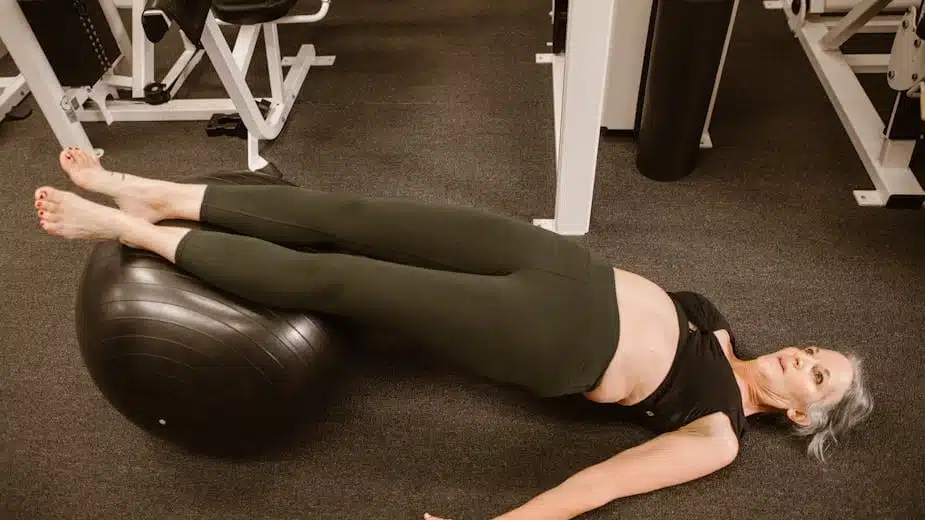Do you suffer from chronic constipation, urinary issues, hemorrhoids or feel pelvic heaviness? You may have perineal descent – a treatable condition where pelvic floor weakness allows organs to drop and press down. Fortunately, understanding what causes perineal descent and how to strengthen pelvic muscles can help resolve symptoms.
This guide explains what perineal descent is, why it happens and how to self-treat it with easy exercises, dietary changes and stress relief. Read on to learn how stabilizing the perineum can improve bowel, bladder and sexual health.
What is perineal descent?
The perineum is a muscular sling filling the bottom of the pelvis, supporting organs like the bladder, uterus and rectum. Perineal descent (also called descending perineum syndrome) happens when these muscles weaken over time and no longer provide enough lift to hold organs in place. This causes prolapse, where organs bulge into the vagina or rectum.
When the perineum descends, it takes the pelvic floor down with it. This can weaken the pelvic floor over time. As a result, you may deal with issues like:
- Chronic constipation
- Fecal incontinence
- Pelvic organ prolapse
- Urinary incontinence
- Pelvic pain
What causes perineal descent?
A variety of factors can contribute to the descent of the perineum, including:
- Chronic Straining: Straining excessively during bowel movements is a prime culprit. Think of your perineum like a trampoline. Repeatedly bearing down hard with constipation is similar to leaving a heavy weight in the middle – eventually the “fabric” stretches out.
- Childbirth: Vaginal delivery can overstretch or injure nerves/muscles. Difficult deliveries or use of forceps raises the risk.
- Menopause: Declining estrogen thins vaginal walls and pelvic floor tissues. This makes prolapse more likely.
- Obesity: Extra abdominal weight strains pelvic muscles. Fatty tissue can also compress nerves.
- Prior Surgery: Hysterectomies, bowel resectioning, hemorrhoidectomy or other pelvic procedures may impart damage.
- Aging: Like other muscles, pelvic floor strength naturally declines over time. Conditions like arthritis or disc disease contribute.
Along with the above, neurological diseases, genetics, and even persistent coughing can increase susceptibility.
Symptoms of perineal descent
Wondering if you may have symptomatic perineal descent? Be on the lookout for issues like:
Bowel Troubles
- Chronic constipation/straining
- Sensation of incomplete evacuation
- Fecal incontinence
- Passing stools frequently
Bladder Concerns
- Urine leakage (stress incontinence)
- Recurrent UTIs
- Trouble starting urine stream
Discomfort
- Heaviness/bulge sensation in rectum or perineum
- Pelvic pain
- Painful intercourse
Appearance Changes
- Expanding hemorrhoids
- Observable perineal bulge
- Rectal prolapse
If you regularly experience any combination of the above, including difficulties with defecation, be sure to consult your doctor for a comprehensive physical examination. They can evaluate if symptomatic perineal descent is present and recommend appropriate treatment.
Getting tested for perineal descent
To check for perineal descent, your physician may first manually examine the perineum for abnormalities. They may also perform tests like:
- Defecography: You’ll defecate a barium paste while technicians x-ray and fluoroscope to pinpoint issues.
- Pelvic MRI: Detailed MRI imaging can reveal pelvic floor dysfunction.
- Anal Manometry: Measures strength of anal sphincter muscles.
- EMG: Records electrical activity of pelvic floor muscles, offering insights into the state of pelvic floor musculature.
Other tests like urodynamics or endoanal ultrasound may also be used. The goal is to pinpoint if you have true anatomic perineal descent syndrome, or if symptoms are due to nerve damage or other pelvic floor dysfunction. This guides the treatment approach.
Is surgery an option?
Here’s the deal – perineal descent itself can’t be surgically fixed, unlike organ prolapse which can be “tacked” back into place. That’s because the main issue is connective tissue laxity and muscle weakness, rather than herniated organs.
Attempts to surgically “lift” or repair the perineum often fail. Stitches and mesh tend to pull loose over time as tissues continue to weaken.
Plus, severing nerves and tissue during anorectal surgery can sometimes make bowel/bladder problems even worse! There are special cases like major prolapse where surgery may help, but it doesn’t treat the underlying pelvic floor dysfunction.
Conservative treatment options that work
The good news is perineal descent CAN get better with non-surgical treatment! Scientific research shows retraining your pelvic floor muscles along with lifestyle changes yields the best long term outcome. Here’s what helps:
Pelvic floor physical therapy
Seeing a qualified pelvic floor PT is hands down the most effective treatment approach. They perform internal and external soft tissue mobilization to release overtight tissues in and around the perineum.
Then they’ll guide you through pelvic floor exercises to reconnect with and strengthen all the layers of your pelvic floor. This includes stretching tight muscles as well as contracting the weakened ones.
Physical therapy also helps retrain coordinated muscle patterns needed for continence and bowel movements. You’ll gain control again.
Dietary changes
Chronic constipation and straining are major contributing factors to perineal descent. Getting regular soft bowel movements can help take pressure off your pelvic floor:
- Increase fiber intake slowly
- Stay hydrated
- Consider probiotic foods
- Use stool softeners if needed
Your PT or doctor can provide more detailed diet guidance to resolve your specific symptoms.
External devices/support
Special devices like vaginal pessaries can provide structural support and lift weakened organs back into proper position. These devices are fitted and managed by your doctor. Wearing a perineal support brace can also take tension off overworked muscles during activity. This gives your pelvic floor a break so it can heal.
Mind-body therapies
Relaxation techniques like diaphragmatic breathing, meditation, yoga, Pilates and tai chi curb anxiety and relax tightened muscles. Biofeedback uses sensors to help you visualize and gain control of muscle contractions.
Restoring pelvic floor strength
Whether you opt for conservative therapy or operations, restoring muscular strength is vital for overcoming perineal descent long-term. Let’s explore some easy yet highly effective tips to heal your pelvic floor at home, which can also aid in the management of rectocele and cystocele.
- Squat Instead of Sit – Avoid placing pressure on delicate tissues. When possible, opt to squat instead of sitting directly on the perineum. Use a small stool to prop heels up when needing to squat for extended periods.
- Ice After Bowel Movements – Icing constricts blood vessels, easing inflammation that strains muscles. Apply an ice pack wrapped in cloth to the perineum for 5-10 minutes after bowel movements to relieve swelling.
- Perform Kegels – Kegels strengthen the pubococcygeus muscle supporting organs and can mitigate issues related to rectocele and the posterior aspect of the pelvic floor. Work up to holding 5-10 seconds, relax 5 seconds. Aim for 5 sets x 10 reps daily, integrating “quick kegels” into your routine too.
- Try Pelvic Tilts – Lie on back with knees bent. Tilt hips up to flatten low back, pulling belly button inwards. Hold 5 seconds. Relax. Repeat 10 times x 2 daily. Limit if this strains or hurts.
- Practice Deep Breathing with Visualization – When bearing down, imagine perineum gently “lifting up” as you inhale through nose. Control exhale through pursed lips. Visualize area softening as breath sends oxygenated blood to tissues.
- Limit Straining – Avoid holding breath and intense pushing during elimination. Support muscles instead with light abdominal engagement, gentle exhales and devices like toilet footstools.
- Explore Yoga and Pilates – Low-impact programs build core awareness and pelvic stability with poses like Bridge or Clam Shells. Check for specialized pelvic floor classes.
Start applying the above tips today to actively strengthen your pelvic floor. Be patient and commit – with time, you’ll notice substantive improvement of the perineal descent.
Take control of your pelvic floor health
Perineal descent and pelvic floor dysfunction can negatively impact bladder/bowel function and even self-esteem. But the earlier you get evaluated and start conservative treatment, the better your chances of managing symptoms long term.
Be your own health advocate and overcome your hesitation to talk openly with your provider. There are many non-surgical options to strengthen your pelvic floor, potentially treating conditions like rectocele and cystocele!
Regaining control of your pelvic stability is possible through pelvic floor physical therapy, dietary modifications, devices, and stress management. Give your body the extra support it needs while doing the work to build back muscle integrity from the inside out.



